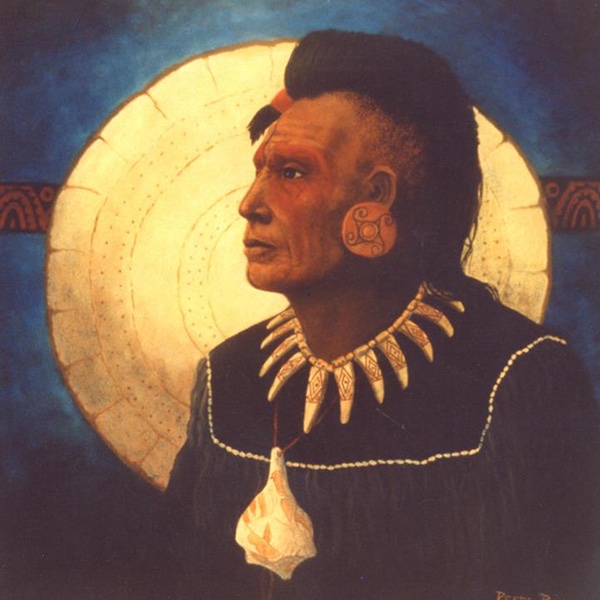Making a Caddo Circle Book

Download lesson plan and included materials
Subject: Mathematics, Social Studies, English Language Arts and Reading, and Art
Grade: 5th and 7th grades
Author: Dr. Mary Black (2003), revised by Mary Rodriguez, Jason Terry, and Emily McCuistion (2024)
Time Duration: One or two 45-minute class periods
Overview: Students will write, draw, and use mathematical skills as they visit each of five short sections to learn about the Caddo Indians of Texas.
TEKS:
Mathematics, Grade 5
- (1A), apply mathematics to problems arising in everyday life, society, and the workplace
- (3D), represent multiplication of decimals with products to the hundredths using objects and pictorial models, including area models
- (4H), represent and solve problems related to perimeter and/or area and related to volume
- (3C), solve with proficiency for quotients of up to a four-digit dividend by a two-digit divisor using strategies and the standard algorithm
Mathematics, Grade 7
- (1A), apply mathematics to problems arising in everyday life, society, and the workplace
- (1C), select tools, including real objects, manipulatives, paper and pencil, and technology as appropriate, and techniques, including mental math, estimation, and number sense as appropriate, to solve problems
- (5B), describe π (pi) as the ratio of the circumference of a circle to its diameter; and
- (5C), solve mathematical and real-world problems involving similar shape and scale drawings
Social Studies, Grade 5
- 25(A), use social studies terminology correctly
- 21(A), describe customs and traditions of various racial, ethnic, and religious groups in the United States
- 25(D), create written and visual material such as journal entries, reports, graphic organizers, outlines, and bibliographies
Social Studies, Grade 7
- 2(A), compare the cultures of American Indians in Texas prior to European colonization such as Gulf, Plains, Puebloan, and Southeastern
- 9(A), identify ways in which Texans have adapted to and modified the environment and explain the positive and negative consequences of the modifications
- 22(A), use social studies terminology correctly
- 22(C), create written, oral, and visual presentations of social studies information
English Language Arts and Reading, Grade 5
- 6(D), create written and visual material such as journal entries, reports, graphic organizers, outlines, and bibliographies
- 6(B), generate questions about text before, during, and after reading to deepen understanding and gain information
- 6(E), make connections to personal experiences, ideas in other texts, and society
- 12(A), compose literary texts such as personal narratives, fiction, and poetry using genre characteristics and craft;
- 12(B), compose informational texts, including brief compositions that convey information about a topic, using a clear central idea and genre characteristics and craft
English Language Arts and Reading, Grade 7
- 5(A), establish purpose for reading assigned and self-selected texts;
- 5(B), generate questions about text before, during, and after reading to deepen understanding and gain information
- 5(E), make connections to personal experiences, ideas in other texts, and society
- 5(H), synthesize information to create new understanding
- 6(C), use text evidence to support an appropriate response
Art, Grade 5
- 2(C), produce drawings; paintings; prints; sculpture, including modeled forms; and other art forms such as ceramics, fiber art, constructions, digital art and media, and photographic imagery using a variety of materials.
Art, Middle School 2
- 1(A), identify and illustrate ideas from direct observation, original sources, imagination, personal experiences, and communities such as family, school, cultural, local, regional, national, and international;
- 2(A), create original artworks that express a variety of ideas based on direct observations, original sources, and personal experiences, including memory, identity, imagination, and the community;
Materials:
- Computer access for: www.texasbeyondhistory.net/kids/caddo
- Student Handout sheet (included)
- Circle handouts (included) or plain paper
- Pens or pencils
- Colored markers
- Scissors
- Stapler
- Rulers (optional)
Activities and Procedures:
Step 1: Students work individually or in pairs. Each student or pair draws a circle approximately eight inches in diameter on each of six sheets of plain paper or teacher can print circle handout provided below. Students cut out all the circles to use for the book.
Step 2: Students read one section about the Caddo at a time and perform the appropriate task from the Student Handout Sheet on one circle of paper. Use one circle for each task. Repeat until all five sections are complete. The tasks can be done in any order.
Step 3: Students make a cover sheet on a separate paper circle with their name, the title “Caddo Indians,” and a drawing to illustrate Caddo life.
Step 4: Students staple all six completed pages together to form a book.
Closure: Students share their writing and drawings with the class, then take the book home to share with family.
Modification: Fewer vocabulary words can be required; the writing assignment can be shortened; fewer math problems can be required, or they can be omitted.
Extension Activities: Students can create more pages for the book by reading the full Caddo exhibit on Texas Beyond History (www.texasbeyondhistory.net/tejas/index.html), adding more drawings, poems, stories, and other products for each section as they wish.
Assessment: Completed circle book with proper use of vocabulary, grammar, and correct mathematics.